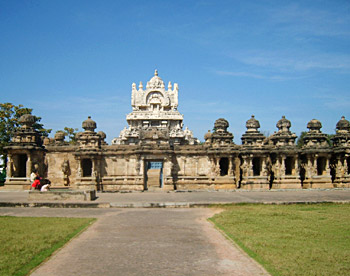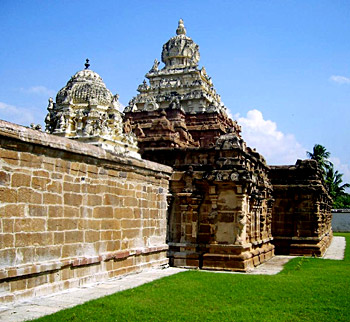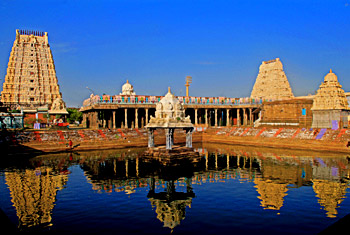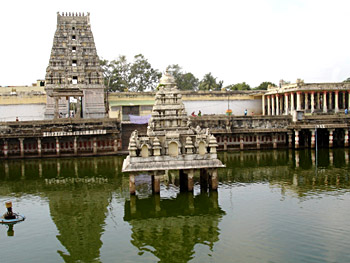 The Golden City of Kanchipuram is one of the seven sacred places of India like Ayodhya, Muttra, Maya (Hardwar), Kashi, Kanchi Avantika (Ujjain) and Dwaraka. These cities are capable of giving salvation to a person. This place is important to worshippers of Shiva, Vishnu as well as of the Divine Mother. So it is no wonder that every day large crowds of pilgrims are pouring into the city from various parts of India.
The Golden City of Kanchipuram is one of the seven sacred places of India like Ayodhya, Muttra, Maya (Hardwar), Kashi, Kanchi Avantika (Ujjain) and Dwaraka. These cities are capable of giving salvation to a person. This place is important to worshippers of Shiva, Vishnu as well as of the Divine Mother. So it is no wonder that every day large crowds of pilgrims are pouring into the city from various parts of India.
The credit goes to the Pallavas for bringing out this well-planned city into existence, supplying it wise all the necessities of the crowded population and decorating it with many artistic places of worship.
The temples of the ancient times with their distinctive features of architecture serve as historic monuments. These are known as the pieces of Pallavs architecture, considering their difference from other temples they have left behind. No stone temples existed before their arrival and the simple structures were later on much improved by the Chola and Vijayanagara kings.
Some of the notable temples of Kanchipuram are Kailasanatha Temple, Vaikunthaperumal Temple, Ekambaranathar Temple, Kamakshi Amman Temple, Varadaraja Perumal Temple, Muktiswarar and Matangeswarar temples, Jain Kanchi temples, Maduranthagam temple and Sriperumpudur Temple.
Kailasanathar Temple of Kanchipuram
 This is a Shiva temple and is one of the earliest temples built by Rajasimha Pallava in the late 7th century A.D. Later, Mahendra Varma III added the front of the temple. It is the only temple of the original Pallava architecture and represents a fine specimen of freshness and simplicity of early Dravidian architecture.
This is a Shiva temple and is one of the earliest temples built by Rajasimha Pallava in the late 7th century A.D. Later, Mahendra Varma III added the front of the temple. It is the only temple of the original Pallava architecture and represents a fine specimen of freshness and simplicity of early Dravidian architecture.
All the gods can be seen here in various aspects in several niches along the circumambulatory path around the sanctum sanctorum. One needs to crawl through a small opening to enter the temple and has to come out of a pit at the end. Pallava paintings can be also seen here.
Vaikunthaperumal Temple of Kanchipuram
The Vishnu shrine in this temple was built between 674 and 850 AD by the Pallava king Parameswara Varman and Nandivarman II. The Pallava history, like their dresses, costumes, jewellery and habits are captured in relief all along the corridors. There are two storeys in this temple and enshrines Vishnu in them. Such storied temple is called `Maadak Kovil` in Tamil. The rich puranic sculptures can be seen on the walls. Lion pillars adorn the cloisters inside the outer wall.
Ekambaranathar Temple of Kanchipuram
This is a Siva temple and is the largest in Kanchipuram. It covers an area over nine hectares. The gopuram or portal tower of the temple is 192 feet high and its massive outer walls were constructed by Krishna Devaraya, the great Vijayanagar king in 1509. The Lord here is known as Ekambaranathar and `Eka Amra` means a single mango tree. A single mango tree can be seen behind the temple. This tree is said to be 35,000 years old, with four branches representing the four Vedas. It is also said that the fruit of each branch has a different taste. The Lingam here is made of earth.
Kamakshi Amman Temple of Kanchipuram
This is the most important temple and the chief deity of Kanchipuram. There is no separate sanctum for Siva here. There is only a separate sanctum for Adi Sankara.
Varadaraja Perumal Temple of Kanchipuram
 This is a Vishnu temple, which was built during the Vijayanagara period. This big temple has five enclosures with huge outer wall and a hundred-pillared hall. The sculptural marvel here is a huge chain carved out of single piece of stone. Several exquisite murals can be seen in its ceiling. One superb thing to be seen here is the golden lizard here. The 100-pillared hall is a perfect specimen of Vijayanagar art and architecture.
This is a Vishnu temple, which was built during the Vijayanagara period. This big temple has five enclosures with huge outer wall and a hundred-pillared hall. The sculptural marvel here is a huge chain carved out of single piece of stone. Several exquisite murals can be seen in its ceiling. One superb thing to be seen here is the golden lizard here. The 100-pillared hall is a perfect specimen of Vijayanagar art and architecture.
Muktiswarar and Matangeswarar Temples of Kanchipuram
These two temples also reflect the Pallava artifacts with fine specimens of art and architecture.
Jain Kanchi Temples of Kanchipuram
A group of Jain temples can be seen on the southwest of the city beyond the river Vegavadhi, one of the tributaries of Palar. This place is known as `Tiruparuthi Kundram`. These are built during the early Chola period. In one of this temple, a `sangeetha mandapam` (music hall) dedicated to Vardhamana Mahavira can be seen. The roof of this temple is adorned with paintings, illustrating the lives of Tirthankaras. Rare Jain manuscripts are also preserved in this temple. The most important of the recent Jain temples in Kanchipuram is the Kumarakkottam. This is dedicated to Lord Muruga.
Maduranthagam Temple of Kanchipuram
 The temple of Maduranthagam is about 80 km south of Chennai on the trunk road to Tiruchy. It is a temple of Sita, the consort of Lord Rama. Lord Rama here is hence known as `Eri Katha Rama` or Rama, the one who guarded the lake, which is the biggest lake of the district. This lake was cut by the Cholas.
The temple of Maduranthagam is about 80 km south of Chennai on the trunk road to Tiruchy. It is a temple of Sita, the consort of Lord Rama. Lord Rama here is hence known as `Eri Katha Rama` or Rama, the one who guarded the lake, which is the biggest lake of the district. This lake was cut by the Cholas.
There is a story behind the construction of this temple here. It is said that in the close of the 18th century when Colonel Lionel Place was the collector, furious monsoon brought unprecedented rains and the lake was full. The bund could break at any moment. When the collector came to examine the bunds he saw a huge figure of Lord Rama with his bow in his hand on the bund. The rain stopped and the breach was prevented by divine grace. The collector then built a sanctum for Sita, the consort of Rama showing his gratitude, which is now situated in the bund of the lake.
Sriperumpudur Temple
This temple is midway between Chennai and Kanchipuram and is the birthplace of saint Ramanuja, the propounder of Vishistadvaita philosophy. The Vijayanagar kings renovated the shrines of the temple. The exquisite testimonials of the Vijayanagara architecture can be seen on the pillars of the temple. The image of Ramanuja is also installed in this Lord Vishnu shrine.
The city of Kanchipuram can be called a museum of precious treasure of ancient art and architecture. Undoubtedly it is the only city in the South which possesses such a wealth of historic material. The temples of Kanchipuram have the capability to raise the antiquarian interest.





















